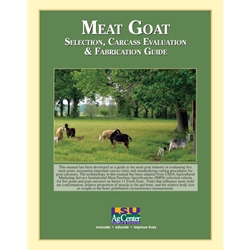Education
Any meat industry benefits from a clear cut understanding between buyer and producer of the quality of the animal being sold. The USDA Agricultural Marketing Service currently has no voluntary grade standards for meat goat carcasses and cuts. However, they have adopted Institutional Meat Purchase Specifications for Fresh Goat and also voluntary standards for live meat goats as follows:
LIVE MEAT GOAT SELECTION STANDARDS updated July 2012
The selection criteria for live goats are based on consideration of conformation (muscling). Selection No. 1 goats or carcasses have a high proportion (by weight) of meat to bone. Selection No. 3 goats and carcasses have a low ration of meat to bone.
 |
Selection No. 1 live goats and/or carcasses have a superior meat type conformation without regard to the presence of fat cover. They shall be thickly muscled throughout the body as indicated by a pronounced (bulging) outside leg (biceps femoris and semitendinosus), a full (rounded) back strip (longissimus dorsi), and a moderately thick outside shoulder (triceps brachii group). |
|
Selection No. 2 live goats and/or carcasses have an average meat type conformation without regard to the presence of fat cover. They shall be moderately muscled throughout the body as indicated by a slightly thick and slightly pronounced outside leg (biceps femoris and semitendinosus), a slightly full (flat or slightly shallow) back strip (longissimus dorsi), and a slightly thick to slightly thin outside shoulder (triceps brachii group).
|
|
Selection No. 3 live goats and/or carcasses have an inferior meat type conformation without regard to the presence of fat cover. The legs, back and shoulders are narrow in relation with its length and they have a very angular and sunken appearance. |
|
For more information, go to the downloadable LSU publication, Meat Goat Selection, Carcass Evaluation and Fabrication Guide. |



